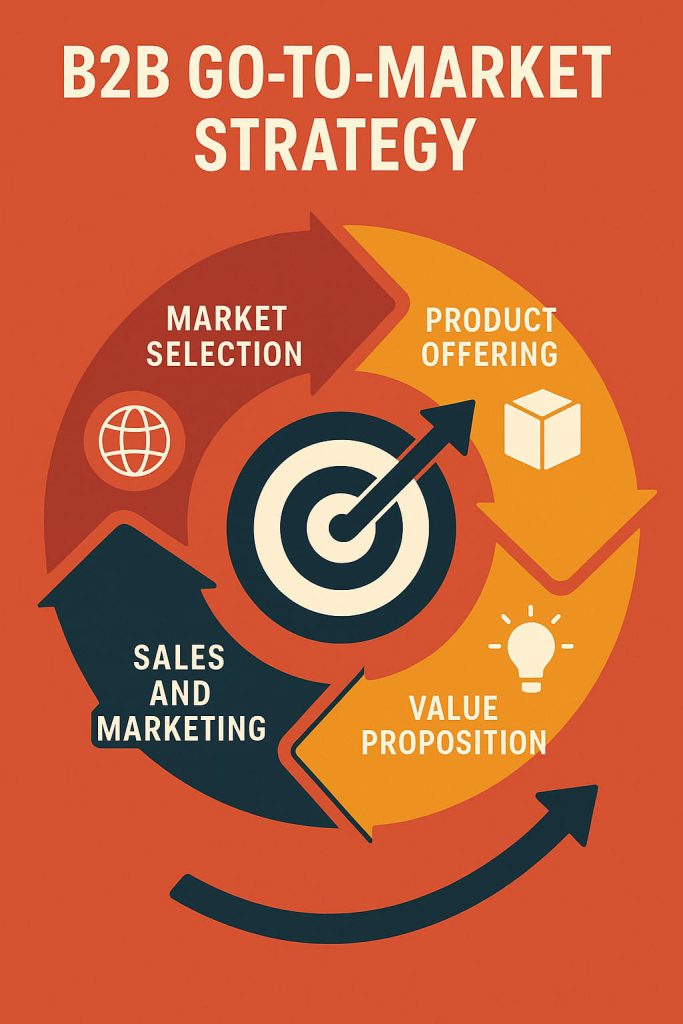B2B Go-to-Market Strategy

Most companies are launching products with B2B go-to-market strategies that are so fundamentally flawed that they might as well be throwing millions into a shredder while blindfolded and setting their quarterly targets on fire. They’re making critical GTM decisions based on internal politics, hastily copied competitor approaches, and whatever half-baked idea the CEO got excited about at the last conference they attended while networking at the hotel bar.
It’s absolute madness….And it’s happening everywhere. Not just at clueless venture-backed startups burning through runway like they found an unlimited money glitch, but at publicly-traded companies with armies of MBAs who should frankly know better but somehow still don’t.
Table of Contents
✅ Listen to this PODCAST EPISODE here:
Why Most B2B Go-to-Market Strategies Fail Spectacularly
Before diving into what actually works, let’s discuss why so many B2B go-to-market strategies fail despite substantial investment, genuine effort, and endless meetings where everyone nods in agreement. The problems aren’t mysterious or unique—they’re shockingly consistent across organizations, like some sort of corporate pandemic:
- The Copy-Paste Disaster: Blindly adopting another company’s GTM strategy without understanding the market conditions that made it successful for them. “Salesforce/HubSpot/Gong did X, so we should do X too!” — completely ignoring that those companies had different products, different markets, different funding situations, and different competitive landscapes. It’s like wearing someone else’s prescription glasses and wondering why you’re getting headaches.
- The Channel Confusion Syndrome: Pursuing too many go-to-market channels simultaneously without the resources to execute any of them properly. “We’ll do direct sales AND channel sales AND self-service AND marketplaces!” Meanwhile, each channel gets a fraction of the resources needed to succeed, ensuring mediocrity across the board. Jack of all channels, master of none.
- The Sales-Marketing Disconnect: Creating separate, unaligned strategies for different functions rather than an integrated approach. Marketing creates campaigns for leads sales doesn’t want. Sales tells stories marketing has never heard. Product builds features neither group knows how to position. It’s like a restaurant where the menu, kitchen, and waitstaff are all from different restaurants.
- The Magical Thinking Problem: Building strategies based on best-case assumptions rather than realistic market conditions. “We’ll capture 15% of a $10B market in 18 months!” based on nothing more than optimism and Excel’s ability to multiply large numbers. Reality arrives like a cold shower about 6 months into the fiscal year.
- The Metrics Mayhem Issue: Failing to establish clear success metrics before launch, making it impossible to evaluate performance or determine if you’re actually succeeding. “We’ll know it when we see it!” No, you won’t. You’ll rationalize whatever happens as either success or a “learning experience.”
- The Target Audience Delusion: Defining target customers so broadly that messaging becomes generic and ineffective. “Our ideal customer is any B2B company with more than 50 employees!” Congratulations, you’ve just targeted millions of companies that have nothing in common except existing.
The CHOICES Framework: Building B2B Go-to-Market Strategies That Actually Work

Customer: Begin With Deep, Specific Understanding (Or Fail Before You Start)
The single biggest mistake in B2B go-to-market strategy is starting with your product rather than your customer. They build an entire GTM strategy around what they’ve built rather than who they’re selling to and why those people would care. It’s like planning a road trip by obsessing over your car’s features instead of deciding where you actually want to go.
The best GTM strategies are built on a foundation of deep, nuanced customer understanding that goes far beyond those superficial, fiction-filled personas marketing teams create to justify their campaigns. Effective customer understanding requires:
- Clearly defined ideal customer profiles based on objective firmographic and behavioral criteria, not just “companies that could use our product” (which is basically everyone with a pulse and a business license)
- Detailed buyer journey mapping that identifies key decision points and influences—the actual messy, non-linear path customers take, not the neat funnel diagram you put in pitch decks
- Deep understanding of the buying committee and each stakeholder’s priorities, including who can say no even if they can’t say yes (often the most important people to convince)
- Crystal clear articulation of customer pain points and how they’re currently addressed, even if the current solution is “doing nothing and living with the pain”
- Specific trigger events that cause prospects to enter buying cycles—what actually gets them off the status quo and into active evaluation mode
Hypothesis: Develop Clear, Testable Market Positioning (Not Generic Marketing Fluff)
With deep customer understanding established, the positioning phase of B2B go-to-market strategy can begin. It’s about developing a clear, compelling hypothesis about why your specific solution is uniquely valuable to your target customers.
- Clear articulation of your unique value proposition relative to alternatives—not just direct competitors but also the status quo and doing nothing (often your biggest competitor)
- Specific, measurable customer outcomes your solution delivers—not vague promises like “digital transformation” or “operational excellence” that could mean anything
- Compelling reason to believe that substantiates your claims—actual proof points that pass the “so what?” test, not just feature lists or marketing speak
- Distinct positioning relative to competitive alternatives that highlights meaningful differences customers actually care about, not just those you’re proud of internally
- Consistency across all customer touchpoints and communications—from your website to your sales deck to what your SDRs say in cold calls
Obstacles: Identify and Address Barriers to Purchase
Even the best-positioned solutions face barriers to purchase. Effective B2B go-to-market strategies proactively identify and address these obstacles rather than hoping they won’t matter. Common obstacles in B2B contexts include:
- Long, complex decision cycles involving multiple stakeholders
- Technical integration challenges
- Security and compliance requirements
- Budget constraints and competing priorities
- Status quo bias and organizational inertia
- Proof requirements before major purchase decisions
Insights: Make Use of Data to Drive Decisions
In the age of data overload, the difference between successful and unsuccessful B2B go-to-market strategies often comes down to which insights you extract and act upon. Effective insight development includes:
- Analysis of past customer acquisition patterns and success factors
- Competitive intelligence on positioning, pricing, and go-to-market approaches
- Market segment performance data to identify highest-potential opportunities
- Customer engagement patterns that reveal interest and buying readiness
- Win/loss analysis to understand decision factors and competition
Channels: Select and Optimize the Right B2B Go-to-Market Strategy Paths

Channel selection is where most B2B go-to-market strategies go sideways. Companies try to pursue too many channels simultaneously, or they select channels based on internal capabilities rather than customer preferences.
Effective channel strategy requires:
- Understanding how your target customers prefer to buy similar solutions
- Realistic assessment of your organization’s channel execution capabilities
- Clear primary and secondary channel designation with appropriate resource allocation
- Detailed channel economic analysis including CAC, LTV, and payback period
- Specific channel development roadmaps and growth plans
Execution: Build Systems for Consistent Implementation
The final element—and where many promising B2B go-to-market strategies ultimately fail—is execution. Great strategies mean nothing without consistent, coordinated implementation.
Effective GTM execution systems include:
- Clear ownership and accountability for each element of the strategy
- Cross-functional alignment on goals, messaging, and approaches
- Detailed implementation roadmaps with specific milestones
- Regular review cadences to evaluate performance and make adjustments
- Leading indicator metrics that provide early warning of issues
Scoring: Measure Performance and Adapt Continuously
The most sophisticated B2B go-to-market strategies include built-in measurement and adaptation mechanisms rather than treating performance evaluation as an afterthought. Effective measurement approaches include:
- Clear definition of success metrics before launch
- Balanced scorecard approach that measures both activities and outcomes
- Regular cadence of performance reviews with key stakeholders
- Benchmark comparison to establish context for results
- Systematic approach to testing and optimizing key elements

Summary: Key Insights for Effective B2B Go-to-Market Strategy
✅ Begin With the Customer: Effective B2B go-to-market strategies start with deep customer understanding, not product features or internal capabilities
✅ Focus Resources: Concentrate on doing a few things excellently rather than many things adequately
✅ Align Functions: Ensure marketing, sales, product, and customer success are executing against a unified strategy
✅ Address Friction: Proactively identify and eliminate obstacles in the buying process
✅ Test Assumptions: Validate key strategic hypotheses before full-scale implementation
✅ Build Operations: Create dedicated go-to-market operations capabilities to ensure consistent execution
✅ Measure Rigorously: Establish clear success metrics and leading indicators to guide optimization
✅ Adapt Continuously: View go-to-market strategy as a dynamic system that requires ongoing refinement
What Makes SIS International a Top Resource for B2B Go-to-Market Strategy
Navigating the complexities of B2B go-to-market strategy isn’t something you can figure out by reading a few LinkedIn articles or copying a competitor’s approach. It requires specialized expertise that goes miles beyond the generalist knowledge most business consultants bring to the table. Here’s why serious organizations rely on ซิส rather than rolling the dice again:
- CUSTOMIZED APPROACH: Generic go-to-market frameworks that claim to work for everyone usually work for no one. At การวิจัยระหว่างประเทศของ SIS, we don’t just rehash the same template with your logo slapped on it—we build custom go-to-market strategies that reflect your specific market’s realities, not some consultant’s favorite framework from business school.
- THE 40+ YEARS OF EXPERIENCE: There’s no substitute for having seen hundreds of go-to-market strategies succeed or fail across decades of work. Firms with long-term specialized experience have pattern recognition capabilities that you simply cannot develop internally without years of seeing what actually works in varied market conditions.
- THE GLOBAL DATABASES FOR THE RECRUITMENT: We maintain access to executive panels, decision-maker networks, and hard-to-reach B2B buyers that would take months or years for an individual company to develop. When you need to interview CISOs at financial institutions or manufacturing COOs to validate your GTM approach, these pre-established relationships become invaluable.
- PROJECTS GET DONE FAST: Internal go-to-market strategy projects are notorious timeline-slippers. What starts as a “let’s have this done by end of month” becomes a six-month odyssey as internal politics, competing priorities, and analysis paralysis take their toll. Meanwhile, your market opportunity shrinks or competitors move ahead. Professional strategy teams can develop, validate, and document comprehensive go-to-market approaches in weeks rather than months because they’re not navigating internal politics, they’re not learning on the job, and they have established methodologies for every step.
- AFFORDABLE RESEARCH: The fully-loaded cost of having internal teams develop a go-to-market strategy—including the opportunity cost of their regular responsibilities, the inevitable mistakes from inexperience, and the cost of delays—almost always exceeds the cost of hiring specialists.
- DEEP INDUSTRY EXPERTISE: Generic business approaches miss the subtle but critical nuances of specific industries. The B2B go-to-market strategy that works brilliantly for enterprise software fails miserably for healthcare technology. What succeeds in financial services crashes and burns in manufacturing. We have deep vertical expertise that allows them to understand the unique buying processes, decision criteria, and competitive dynamics of particular industries in ways that generalist teams simply cannot match.
- ANALYTICAL RIGOR: The difference between opinion-based and evidence-based go-to-market strategy is analytical rigor. Too many internal GTM strategies are built on anecdotes, executive opinions, and sales team feedback rather than systematic research and analysis. Professional strategists apply structured analytical frameworks that reveal market opportunities and challenges that subjective approaches almost always miss.
FAQs: B2B Go-to-Market Strategy
How should B2B go-to-market strategy differ for new products vs. established offerings?
For new products entering the market, effective go-to-market strategies typically include:
- Higher investment in market education and problem awareness
- More focused targeting on early adopter segments most likely to embrace innovation
- Greater emphasis on risk mitigation to overcome status quo bias
- More flexible pricing approaches to encourage initial adoption
- Heavier reliance on high-touch sales processes until product-market fit is clearly established
- More investment in customer success to ensure initial implementations succeed
For established products with proven product-market fit, go-to-market strategies often evolve toward:
- More scalable, lower-touch acquisition channels
- Broader market targeting beyond early adopter segments
- More standardized sales methodologies and enablement
- More emphasis on competitive differentiation rather than category education
- Greater focus on operational efficiency and unit economics
- More sophisticated segmentation and personalization
How do you determine the right channel mix for B2B offerings?
Channel selection represents one of the most consequential decisions in B2B go-to-market strategy, yet many companies approach it based on internal preferences rather than external realities. Effective channel strategy development requires:
- Customer buying preferences: Understanding how your target customers prefer to evaluate and purchase similar solutions
- Solution complexity: Assessing whether your offering requires high-touch explanation and customization or can be effectively sold through lower-touch channels
- Market maturity: Determining whether you’re selling into an established category with clear buying processes or creating a new category that requires education
- Economic analysis: Calculating the fully-loaded customer acquisition costs and lifetime value by channel
- พลวัตของการแข่งขัน: Evaluating how competitors go to market and whether differentiation is possible
- Organizational capabilities: Honestly assessing your company’s ability to execute effectively in different channels
- Scale requirements: Determining which channels can efficiently deliver your growth targets
How do you effectively measure B2B go-to-market strategy performance?
Effective measurement of B2B go-to-market performance goes far beyond simplistic metrics like lead volume or win rates. Comprehensive measurement addresses both effectiveness (are we achieving our goals?) and efficiency (are we doing so economically?):
- Pipeline metrics:
- Volume of qualified opportunities by source, segment, and product
- Conversion rates between pipeline stages
- Velocity through the buying process
- Deal size and composition trends
- Financial metrics:
- Customer acquisition costs by channel and segment
- Customer lifetime value and payback period
- Marketing and sales ROI by program and activity
- Revenue impact of specific go-to-market initiatives
- Customer metrics:
- Win rates against different competitors
- Loss reasons and competitive displacement patterns
- Customer satisfaction and product adoption
- Expansion and retention patterns
- Operational metrics:
- Marketing and sales productivity
- Channel partner performance
- Content effectiveness and engagement
- Technology utilization and adoption.
How do you balance standardization and customization in enterprise B2B sales?
This question highlights one of the central tensions in B2B go-to-market execution: how to deliver the personalized experiences that enterprise buyers expect while maintaining the operational efficiency that scale requires. Effective approaches include:
- Modular sales processes: Creating standardized building blocks that can be configured for different buying scenarios rather than forcing all opportunities through identical steps
- Tiered customization: Establishing clear criteria for which customers and opportunities justify higher levels of customization rather than treating all prospects equally
- Templatized personalization: Developing frameworks that enable efficient customization of proposals, presentations, and materials without starting from scratch each time
- Value-based segmentation: Differentiating service levels based on potential customer value rather than treating all prospects identically
- Technology enablement: Implementing systems that automate routine elements of customization while preserving human judgment for high-value activities
How do you successfully implement a new B2B go-to-market strategy across functions?
Even brilliantly designed B2B go-to-market strategies often fail in implementation due to organizational resistance, skill gaps, or coordination challenges. Effective implementation approaches include:
- Cross-functional ownership: Establishing a dedicated go-to-market leadership team with representation from marketing, sales, product, and customer success rather than allowing any single function to dominate
- Clear change story: Articulating why the new strategy is necessary, how it will work, and what success looks like in terms that resonate with different stakeholders
- Capability development: Identifying and addressing skill gaps through training, hiring, or external partnerships before expecting full execution
- Systems alignment: Ensuring that technology, data, and processes support the new strategy rather than reinforcing old behaviors
- Incentive restructuring: Aligning compensation and recognition to reward behaviors that support the new strategy
- Lighthouse implementation: Starting with a focused implementation in one segment or region to demonstrate success before full-scale rollout
สถานที่ตั้งโรงงานของเราในนิวยอร์ก
11 E 22nd Street, ชั้น 2, นิวยอร์ก, NY 10010 T: +1(212) 505-6805
เกี่ยวกับ เอสไอเอส อินเตอร์เนชั่นแนล
เอสไอเอส อินเตอร์เนชั่นแนล เสนอการวิจัยเชิงปริมาณ เชิงคุณภาพ และเชิงกลยุทธ์ เราให้ข้อมูล เครื่องมือ กลยุทธ์ รายงาน และข้อมูลเชิงลึกเพื่อการตัดสินใจ นอกจากนี้เรายังดำเนินการสัมภาษณ์ การสำรวจ การสนทนากลุ่ม และวิธีการและแนวทางการวิจัยตลาดอื่นๆ ติดต่อเรา สำหรับโครงการวิจัยการตลาดครั้งต่อไปของคุณ


